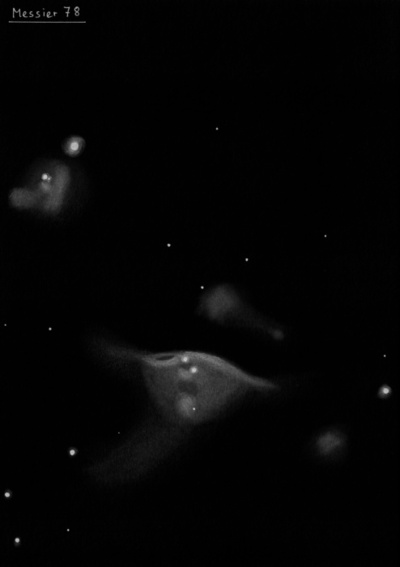
Pierre Méchain discovered M78 = NGC 2068 = h368 in March 1780. On 19 Dec 1783 William Herschel described M78 as "Two large [bright] stars, well defined, within a nebulous glare of light resembling that in Orion's sword. There are also three very small [faint] stars just visible in the nebulous part which seem to be component particles thereof. I think there is a faint ray near 1/2 deg long towards the east and another towards the south east less extended, but I am not quite so well assured of the reality of these latter phenomena as I could wish, and would rather ascribe them to some deception. At least I shall suspend my judgement till I have seen it again in very fine weather, tho' the night is far from bad." M78 was the first reflection nebula that was discovered.
On 9 Jan 1856 the observer on the 72" (R.J. Mitchell) wrote, "in finder eyepiece a B oval neb with n and nf edges brightest and best defined, and sp edge fading away gradually; with higher power there is seen a decided darkness at and between the stars. I can confirm previous observation as to the curve formed by the brightest part of the neb."
Joseph Turner sketched the nebula in Dec 1876 using the 48" Great Melbourne Telescope - plate III, figure 31 at www.docdb.net/history/texts/1885osngmt________e/lithograph_m_3_31.php, as well as Pietro Baracchi on 8 Dec 1884.
200/250mm - 8" (12/6/80): bright reflection nebula, large, NW edge brighter and sharper, elongated, roughly rectangular, wide pair of mag 10 stars involved, striking. Brightest in a group of reflection nebulae.
400/500mm - 17.5" (12/20/95): very bright reflection nebula surrounding two mag 10.5 stars with a mag 13 star involved at the south end. Large, irregular shape, 6'x4'. Brightest along the north side which has a sharply defined slightly bowed-out edge with one of the mag 10.5 stars near the midpoint. A brighter knot is just following this star. The nebula irregularly fans out towards the south and fades with no distinct borders but tapers somewhat at the south edge.
17.5" (2/1/92):very bright, surprisingly large, 6'x4'. Surrounds two mag 10 stars although the nebulosity extends further to east of these stars. Also a mag 13 star is embedded in the SE end. Brighter and sharper edge gently curves from west to north side. Appears to fan out to the SE where the nebula gradually fades into background. Brightest in a group of reflection nebulae including NGC 2064 7' SW and NGC 2067 6' WNW.
Notes by Steve Gottlieb